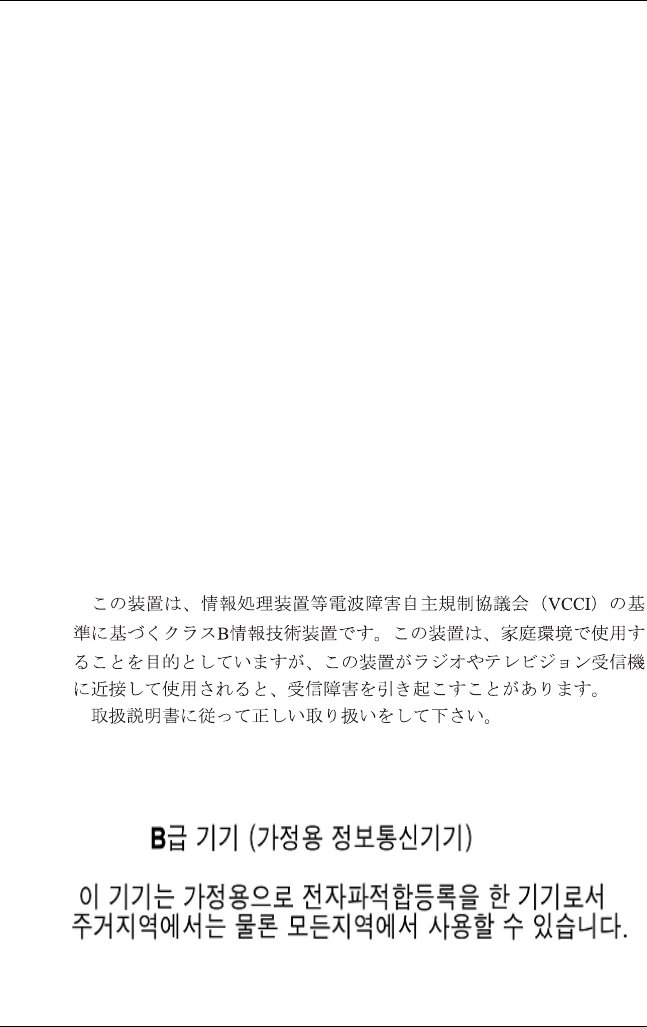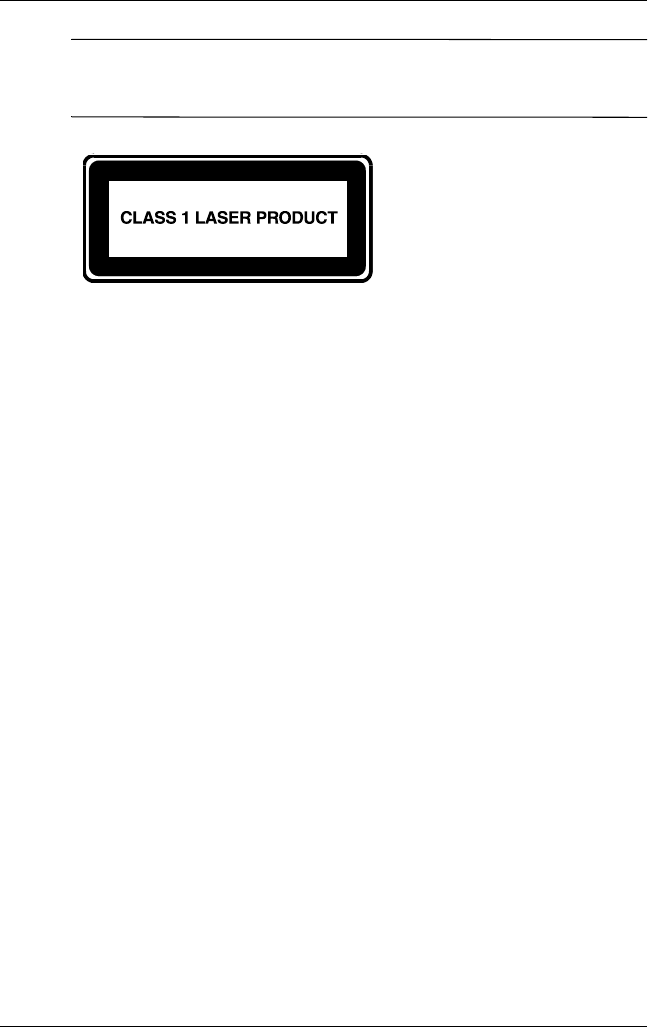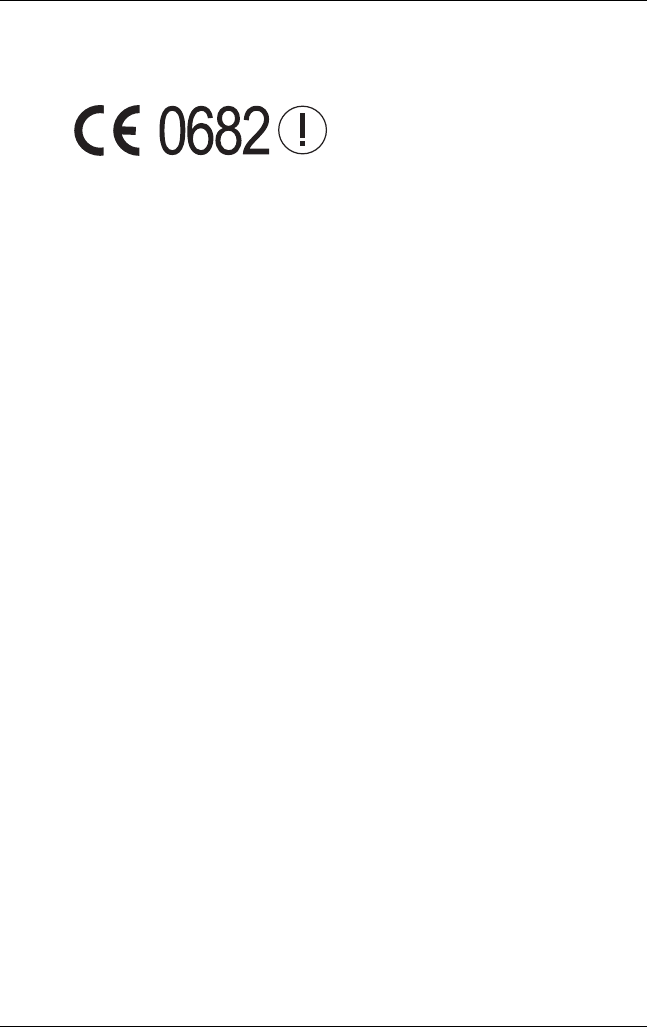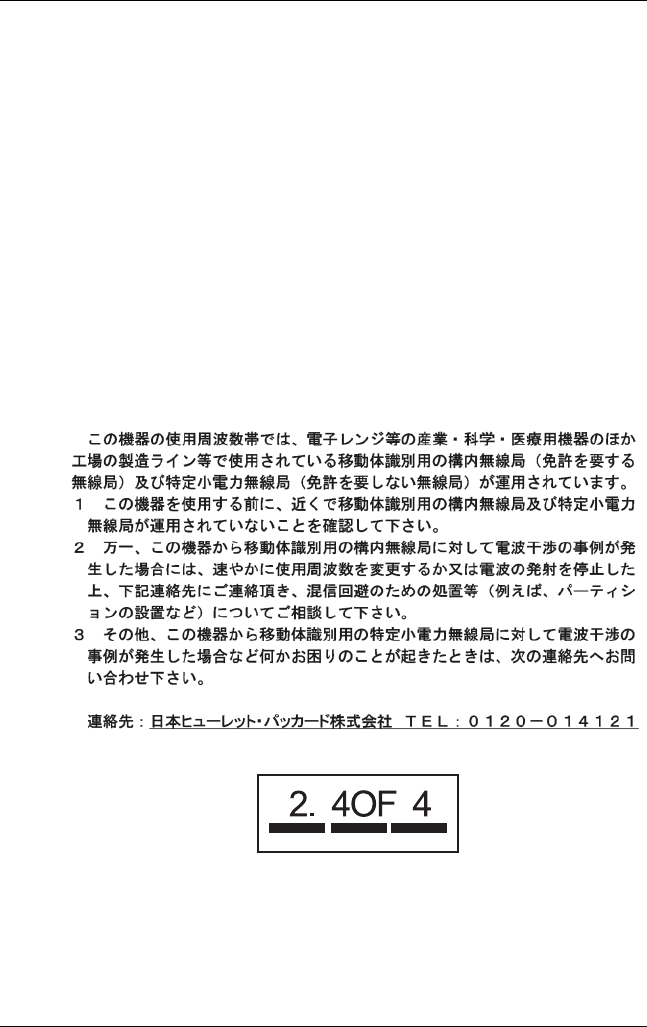Broadcom BRCM1002-H 802.11b WLAN Mini-PCI Module User Manual Regulatory and Safety Notices
Broadcom Corporation 802.11b WLAN Mini-PCI Module Regulatory and Safety Notices
Broadcom >
Contents
- 1. User Manual
- 2. CRN 10069 Q2 HP CRVSA 02T1 75 user manual
- 3. CRN 10069 Q2 HP PP2180 user manual 1 of 2
- 4. CRN 10069 Q2 HP PP2180 user manual 2 of 2
- 5. CRN 10069 Q2 HP PP2180 user manual Regulatory statement
- 6. CRN 9475 Q1 notebook user manual
- 7. CRN 10072 Q3 notebook user manual
- 8. CRN 10072 Q3 regulatory info
- 9. CRN 10072 Q3 Wireless regulatory info
CRN 10069 Q2 HP PP2180 user manual Regulatory statement
Regulatory and Safety Notices
Document Part Number: 339645-001
August 2003
This guide provides governmental agency notices concerning
wireless communication and all other governmental agency
information. Instructions for preventing damage from
electrostatic discharge are also included.
339645-001.book Page i Wednesday, May 28, 2003 12:47 PM
© 2003 Hewlett-Packard Development Company, L.P.
The information contained herein is subject to change without notice. The
only warranties for HP products and services are set forth in the express
warranty statements accompanying such products and services. Nothing
herein should be construed as constituting and additional warranty. HP
shall not be liable for technical or editorial errors or omissions contained
herein.
Regulatory and Safety Notices
First Edition August 2003
Document Part Number: 339645-001
339645-001.book Page ii Wednesday, May 28, 2003 12:47 PM

Regulatory and Safety Notices iii
Contents
1 Regulatory and Wireless Notices
Federal Communications Commission Notice. . . . . . . . . 1–1
Modifications. . . . . . . . . . . . . . . . . . . . . . . . . . . . . . . 1–2
Cables . . . . . . . . . . . . . . . . . . . . . . . . . . . . . . . . . . . . 1–2
Declaration of Conformity for Products Marked
with the FCC Logo (United States Only) . . . . . . . . . 1–2
Canadian Notice . . . . . . . . . . . . . . . . . . . . . . . . . . . . . . . . 1–3
Avis Canadien . . . . . . . . . . . . . . . . . . . . . . . . . . . . . . . . . 1–3
Japanese Notice . . . . . . . . . . . . . . . . . . . . . . . . . . . . . . . . 1–3
Korean Notice . . . . . . . . . . . . . . . . . . . . . . . . . . . . . . . . . 1–3
Airline Travel Notice . . . . . . . . . . . . . . . . . . . . . . . . . . . . 1–4
Power Cords Notice . . . . . . . . . . . . . . . . . . . . . . . . . . . . . 1–4
Battery Notice . . . . . . . . . . . . . . . . . . . . . . . . . . . . . . . . . 1–5
Energy Star Compliance . . . . . . . . . . . . . . . . . . . . . . . . . 1–5
German Ergonomics Notice. . . . . . . . . . . . . . . . . . . . . . . 1–6
Macrovision Corporation Notice . . . . . . . . . . . . . . . . . . . 1–6
Laser Safety Notices . . . . . . . . . . . . . . . . . . . . . . . . . . . . 1–6
CDRH Regulations . . . . . . . . . . . . . . . . . . . . . . . . . . 1–6
Laser Information . . . . . . . . . . . . . . . . . . . . . . . . . . . 1–7
Modem Notices . . . . . . . . . . . . . . . . . . . . . . . . . . . . . . . . 1–8
Important Safety Instructions . . . . . . . . . . . . . . . . . . 1–8
Telecommunications Device Approvals . . . . . . . . . . 1–8
U.S. Modem Statements . . . . . . . . . . . . . . . . . . . . . . 1–9
Canadian Modem Statements . . . . . . . . . . . . . . . . . 1–11
New Zealand Modem Statements . . . . . . . . . . . . . . 1–12
339645-001.book Page iii Wednesday, May 28, 2003 12:47 PM

iv Regulatory and Safety Notices
Contents
Wireless Notices. . . . . . . . . . . . . . . . . . . . . . . . . . . . . . . 1–14
European Union Notice . . . . . . . . . . . . . . . . . . . . . . . . . 1–15
Japanese Regulatory Wireless Notice . . . . . . . . . . . . . . 1–16
Brazilian Regulatory Wireless Notice . . . . . . . . . . . . . . 1–17
2 Electrostatic Discharge
Preventing Electrostatic Discharge . . . . . . . . . . . . . . . . . 2–1
Handling Drives. . . . . . . . . . . . . . . . . . . . . . . . . . . . . 2–1
Handling Internal Components . . . . . . . . . . . . . . . . . 2–1
Grounding Methods . . . . . . . . . . . . . . . . . . . . . . . . . . . . . 2–2
339645-001.book Page iv Wednesday, May 28, 2003 12:47 PM

Regulatory and Safety Notices 1–1
1
Regulatory and Wireless
Notices
This chapter provides all country-specific regulatory notices and
compliance information for your notebook including wireless
notices.
Federal Communications Commission
Notice
This equipment has been tested and found to comply with
the limits for a Class B digital device, pursuant to Part 15 of the
FCC Rules. These limits are designed to provide reasonable
protection against harmful interference in a residential
installation. This equipment generates, uses, and can radiate
radio frequency energy and, if not installed and used in
accordance with the instructions, may cause harmful interference
to radio communications. However, there is no guarantee that
interference will not occur in a particular installation.
If this equipment does cause harmful interference to radio or
television reception, which can be determined by turning the
equipment off and on, the user is encouraged to try to correct the
interference by one or more of the following measures:
■Reorient or relocate the receiving antenna.
■Increase the separation between the equipment and receiver.
■Connect the equipment into an outlet on a circuit different
from that to which the receiver is connected.
■Consult the dealer or an experienced radio or television
technician for help.
339645-001.book Page 1 Wednesday, May 28, 2003 12:47 PM

1–2 Regulatory and Safety Notices
Regulatory and Wireless Notices
Modifications
The FCC requires the user to be notified that any changes or
modifications made to this device that are not expressly approved
by Hewlett-Packard may void the user’s authority to operate the
equipment.
Cables
Connections to this device must be made with shielded cables
with metallic RFI/EMI connector hoods to maintain compliance
with FCC Rules and Regulations.
Declaration of Conformity for Products
Marked with the FCC Logo
(United States Only)
This device complies with Part 15 of the FCC Rules. Operation
is subject to the following two conditions:
1. This device may not cause harmful interference.
2. This device must accept any interference received, including
interference that may cause undesired operation.
If you have questions about your product that are not related
to this declaration, refer to the printed Worldwide Telephone
Numbers booklet included with your product for customer
support information. Or write to:
Hewlett-Packard Company
P. O. Box 692000, Mail Stop 530113
Houston, TX 77269-2000
339645-001.book Page 2 Wednesday, May 28, 2003 12:47 PM

Regulatory and Wireless Notices
Regulatory and Safety Notices 1–3
For questions regarding this FCC declaration, write to:
Hewlett-Packard Company
P. O. Box 692000, Mail Stop 510101
Houston, TX 77269-2000
Or call HP at 281-514-3333.
To identify your product, refer to the part, series, or model
number found on the product.
Canadian Notice
This Class B digital apparatus meets all requirements of the
Canadian Interference-Causing Equipment Regulations.
Avis Canadien
Cet appareil numérique de la classe B respecte toutes les
exigences du Règlement sur le matériel brouilleur du Canada.
Japanese Notice
Korean Notice
339645-001.book Page 3 Wednesday, May 28, 2003 12:47 PM

1–4 Regulatory and Safety Notices
Regulatory and Wireless Notices
Airline Travel Notice
Use of electronic equipment aboard commercial aircraft is at the
discretion of the airline.
ÅWARNING: To reduce the risk of electric shock, fire, or damage to the
equipment, do not attempt to power the computer with a voltage
converter kit sold for appliances.
Power Cords Notice
If you were not provided with a power cord for your notebook
or for an external power accessory intended for use with your
notebook, you should purchase a power cord that is approved for
use in your country.
The power cord must be rated for the product and for the voltage
and current marked on the product’s electrical ratings label. The
voltage and current rating of the cord should be greater than the
voltage and current rating marked on the product. In addition, the
diameter of the wire must be a minimum of 0.75 mm²/18AWG,
and the length of the cord must be between 1.5 m (5 feet) and 2 m
(6½ feet). If you have questions about the type of power cord to
use, contact your HP authorized service provider.
A power cord should be routed so that it is not likely to be walked
on or pinched by items placed upon it or against it. Particular
attention should be paid to the plug, electrical outlet, and the
point where the cord exits from the product.
Only an AC adapter provided with the notebook, a replacement
AC adapter provided by HP, or an AC adapter purchased as an
option from HP should be used with the notebook.
339645-001.book Page 4 Wednesday, May 28, 2003 12:47 PM

Regulatory and Wireless Notices
Regulatory and Safety Notices 1–5
Battery Notice
ÅWARNING: To reduce the risk of fire or burns, do not disassemble,
crush, puncture, short the external contacts on, or dispose of a notebook
battery pack in fire or water. Replace only with the HP battery pack for
this notebook.
NIn North America, dispose of nickel metal hydride or lithium ion
batteries by taking advantage of the notebook battery recycling
program. This program provides you with a postage-paid battery
pack mailer preaddressed to a reclamation facility where the metals
are recycled. For more information, visit the recycling program Web
site at https://www.orderz.com/recycle.
In Europe, do not dispose of batteries with general household waste.
Dispose of or recycle them by using the public collection system or
returning them to HP, your authorized HP partners, or their agents.
CAUTION
RISK OF EXPLOSION IF BATTERY IS REPLACED
BY AN INCORRECT TYPE.
DISPOSE OF USED BATTERIES ACCORDING
TO THE INSTRUCTIONS.
Energy Star Compliance
This notebook is compliant with the U.S. Environmental
Protection Agency (EPA) Energy Star Computers Program 3.0.
The EPA Energy Star logo does not imply endorsement by the
EPA. As an Energy Star Partner, HP has determined that the
product meets the Energy Star guidelines for energy efficiency.
N
339645-001.book Page 5 Wednesday, May 28, 2003 12:47 PM

1–6 Regulatory and Safety Notices
Regulatory and Wireless Notices
German Ergonomics Notice
HP notebooks bearing the “GS” approval mark meet the
applicable ergonomic requirements when used in conjunction
with docking bases, keyboards, and monitors that bear the “GS”
approval mark. HP notebooks in a stand-alone mode are not
intended for continuous use in an office environment.
Macrovision Corporation Notice
This product incorporates copyright protection technology that
is protected by method claims of certain U.S. patents and other
intellectual property rights owned by Macrovision Corporation
and other right owners. Use of this copyright protection
technology must be authorized by Macrovision Corporation,
and is intended for home and other limited viewing uses only,
unless otherwise authorized by Macrovision Corporation.
Reverse engineering or disassembly is prohibited.
Laser Safety Notices
All HP systems equipped with laser products comply with
appropriate safety standards, including IEC 825. With specific
regard to the laser, the equipment complies with laser product
performance standards set by government agencies for Class 1
laser products. It does not emit hazardous light; the beam is
totally enclosed during all modes of customer operation and
maintenance.
CDRH Regulations
The Center for Devices and Radiological Health (CDRH) of the
U.S. Food and Drug Administration implemented regulations
for laser products on August 2, 1976. These regulations apply to
laser products manufactured from August 1, 1976. Compliance is
mandatory for products marketed in the United States.
339645-001.book Page 6 Wednesday, May 28, 2003 12:47 PM

Regulatory and Wireless Notices
Regulatory and Safety Notices 1–7
ÅWARNING: Use of controls or adjustments or performance of
procedures other than those specified herein or in the laser product
installation guide may result in hazardous radiation exposure.
Laser Information
Laser Type: Semiconductor GaAlAs
Wave Length: 780 ± 35 nm
Divergence Angle: 53.5° ± 1.5°
Output Power: Less than 0.2mW or 10,869 W·m-2sr-1
Polarization: Circular
Numerical Aperture: 0.45 ± 0.04
Only authorized technicians trained by HP should attempt to
repair this equipment. All troubleshooting and repair procedures
are detailed to allow only subassembly/module level repair.
Because of the complexity of the individual boards and
subassemblies, no one should attempt to make repairs at the
component level or to make modifications to any printed wiring
board. Improper repairs can create a safety hazard.
This system is classified
as a Class 1 laser product.
This label appears on the
laser product.
339645-001.book Page 7 Wednesday, May 28, 2003 12:47 PM

1–8 Regulatory and Safety Notices
Regulatory and Wireless Notices
Modem Notices
Important Safety Instructions
ÅWARNING: When using this device, basic safety precautions should
always be followed to reduce the risk of fire, electric shock, and injury
to persons, including the following:
■Do not use this product near water, for example, near a bathtub,
wash bowl, kitchen sink or laundry tub, in a wet basement, or near
a swimming pool.
■Avoid using this product during an electrical storm. There may be a
remote risk of electric shock from lightning.
■Do not use this product to report a gas leak in the vicinity of
the leak.
■Always disconnect the modem cable before opening the equipment
enclosure or touching an uninsulated modem cable, jack, or
internal component.
■If this product was not provided with a telephone line cord, use only
No. 26 AWG or larger telecommunication line cord in order to
reduce the risk of fire.
■Do not plug a modem or telephone cable into the network (RJ-45)
jack.
SAVE THESE INSTRUCTIONS
339645-001.book Page 8 Wednesday, May 28, 2003 12:47 PM

Regulatory and Wireless Notices
Regulatory and Safety Notices 1–9
Telecommunications Device Approvals
The telecommunications device in your notebook is approved
for connection to the telephone network in the countries whose
approval markings are indicated on the product label located on
the bottom of the notebook or on the modem.
Refer to the documentation included with the product to ensure
the product is configured for the country in which it is located.
Selecting a country other than the one in which it is located may
cause your modem to be configured in a way that violates the
telecommunication regulations/laws of that country. In addition,
your modem may not function properly if the correct country
selection is not made. If, when selecting a country, a message
appears that states that the country is not supported, this means
that the modem has not been approved for use in this country and
thus should not be used.
U.S. Modem Statements
This equipment complies with Part 68 of the FCC rules and
the requirements adopted by the ACTA. On the bottom of the
computer or on the modem is a label that contains, among
other information, a product identifier in the format
US:AAAEQ##TXXXX. If requested, this information must
be provided to the telephone company.
Applicable certification jack USOC = RJ11C. A plug and jack
used to connect this equipment to the premises wiring and
telephone network must comply with the applicable FCC Part 68
rules and requirements adopted by the ACTA. A compliant
telephone cord and modular plug is provided with this product.
It is designed to be connected to a compatible modular jack that
is also compliant. See installation instructions for details.
339645-001.book Page 9 Wednesday, May 28, 2003 12:47 PM

1–10 Regulatory and Safety Notices
Regulatory and Wireless Notices
The REN is used to determine the number of devices that may be
connected to a telephone line. Excessive RENs on a telephone
line may result in the devices not ringing in response to an
incoming call. In most but not all areas, the sum of RENs should
not exceed five (5.0). To be certain of the number of devices that
may be connected to a line, as determined by the total RENs,
contact the local telephone company. For products approved after
July 23, 2001, the REN for this product is part of the product
identifier that has the format US:AAAEQ##TXXXX. The digits
represented by ## are the REN without a decimal point (e.g., 03 is
a REN of 0.3). For earlier products, the REN is separately shown
on the label.
If this HP equipment causes harm to the telephone network, the
telephone company will notify you in advance that temporary
discontinuance of service may be required. But, if advance notice
isn’t practical, the telephone company will notify the customer as
soon as possible. Also, you will also be advised of your right to
file a complaint with the FCC if you believe it is necessary.
The telephone company may make changes to its facilities,
equipment, operations or procedures that could affect the
operation of the equipment. If this happens the telephone
company will provide advance notice in order for you to make
necessary modifications to maintain uninterrupted telephone
service.
If trouble is experienced with this HP equipment, refer to the
printed Worldwide Telephone Numbers booklet included with
your notebook for information about obtaining customer support.
If the equipment is causing harm to the telephone network,
the telephone company may request that you disconnect the
equipment until the problem is resolved. You should only
perform repairs to the equipment specifically discussed in the
“Troubleshooting” section of the user guide, if one is provided.
Connection to party line service is subject to state tariffs. Contact
the state public utility commission, public service commission or
corporation commission for information.
339645-001.book Page 10 Wednesday, May 28, 2003 12:47 PM

Regulatory and Wireless Notices
Regulatory and Safety Notices 1–11
If your home has specially wired alarm equipment connected to
the telephone line, ensure the installation of this HP equipment
does not disable your alarm equipment. If you have questions
about what will disable alarm equipment, consult your telephone
company or a qualified installer.
The Telephone Consumer Protection Act of 1991 makes it
unlawful for any person to use a computer or other electronic
device, including fax machines, to send any message unless
such message clearly contains in a margin at the top or bottom
of each transmitted page or on the first page of the transmission,
the date and time it is sent and an identification of the business,
other entity, or other individual sending the message and the
telephone number of the sending machine or such business, other
entity, or individual. (The telephone number provided may not be
a 900 number or any other number for which charges exceed local
or long-distance transmission charges.)
In order to program this information into your fax machine, you
should complete the steps outlined in the faxing software
instructions.
Canadian Modem Statements
This equipment meets the applicable Industry Canada technical
specifications.
The Ringer Equivalence Number, REN, is an indication of the
maximum number of devices allowed to be connected to a
telephone interface. The termination on an interface may consist
of any combination of devices subject only to the requirement
that the sum of the RENs of all devices does not exceed 5. The
REN for this terminal equipment is 1.0.
339645-001.book Page 11 Wednesday, May 28, 2003 12:47 PM

1–12 Regulatory and Safety Notices
Regulatory and Wireless Notices
New Zealand Modem Statements
The grant of a Telepermit for any item of terminal equipment
indicates only that Telecom has accepted that the item complies
with minimum conditions for connection to its network. It
indicates no endorsement of the product by Telecom, nor does
it provide any sort of warranty. Above all, it provides no
assurance that any item will work correctly in all respects with
another item of Telepermitted equipment of a different make or
model, nor does it imply that any product is compatible with all
of Telecom’s network services.
This equipment is not capable, under all operating conditions,
of correct operation at the higher speeds for which it is designed.
Telecom will accept no responsibility should difficulties arise in
such circumstances.
If this device is equipped with pulse dialing, note that there is
no guarantee that Telecom lines will always continue to support
pulse dialing.
Use of pulse dialing, when this equipment is connected to the
same line as other equipment, may give rise to bell tinkle or noise
and may also cause a false answer condition. Should
such problems occur, the user should not contact the Telecom
Faults Service.
This equipment may not provide for the effective hand-over of a
call to another device connected to the same line.
339645-001.book Page 12 Wednesday, May 28, 2003 12:47 PM

Regulatory and Wireless Notices
Regulatory and Safety Notices 1–13
Some parameters required for compliance with Telecom’s
Telepermit requirements are dependent on the equipment (PC)
associated with this device. The associated equipment shall be
set to operate within the following limits for compliance with
Telecom’s Specifications:
a. There shall be no more than 10 call attempts to the same
number within any 30-minute period for any single
manual call initiation.
b. The equipment shall go on-hook for a period of not less
than 30 seconds between the end of one attempt and the
beginning of the next attempt.
Where automatic calls are made to different numbers, the
equipment shall be set to go on-hook for a period of not less than
5 seconds between the end of one attempt and the beginning of
the next attempt.
The equipment shall be set to ensure that calls are answered
between 3 and 30 seconds of receipt of ringing (S0 set between
2 and 10).
Voice Support
All persons using this device for recording telephone
conversations shall comply with New Zealand law. This
requires that at least one part to the conversation is to be
aware that it is being recorded. In addition, the Principles
enumerated in the Privacy Act 1993 shall be complied with
in respect to the nature of the personal information collected,
the purpose for its collection, how it is to be used and what is
disclosed to any other party.
This equipment shall not be set to make automatic calls to the
Telecom ‘111’ Emergency Service.
339645-001.book Page 13 Wednesday, May 28, 2003 12:47 PM

1–14 Regulatory and Safety Notices
Regulatory and Wireless Notices
Wireless Notices
In some situations or environments, the use of wireless devices
may be restricted by the proprietor of the building or responsible
representatives of the organization. Such restrictions may
apply when:
■Using the wireless equipment on airplanes, or
■The risk of interference to other devices or services is
perceived as harmful.
If you are uncertain of the policy that applies on the use of
wireless equipment in a specific organization or environment
(such as airports), you are encouraged to ask for authorization to
use this device prior to turning on the equipment.
ÅWARNING: Exposure to Radio Frequency Radiation
The radiated output power of this device is below the FCC radio
frequency exposure limits. Nevertheless, the device should be
used in such a manner that the potential for human contact
during normal operation is minimized. To avoid the possibility
of exceeding the FCC radio frequency exposure limits, human
proximity to the antenna should not be less than 20 cm
(8 inches) during normal operation, including when the
notebook display is closed.
339645-001.book Page 14 Wednesday, May 28, 2003 12:47 PM

Regulatory and Wireless Notices
Regulatory and Safety Notices 1–15
European Union Notice
Products bearing the CE marking comply with the R&TTE
Directive (1999/5/EC), EMC Directive (89/336/EEC) and the
Low Voltage Directive (73/23/EEC) issued by the Commission
of the European Community. CE compliance of this computer
is valid only if powered with an HP provided CE marked AC
adaptor.
Compliance with these directives implies conformity to the
following European Norms (in parentheses are the equivalent
international standards and regulations):
■EN 55022 (CISPR 22)—Electromagnetic Interference
■EN55024 (IEC61000-4-2, 3, 4, 5, 6, 8, 11)—Electromagnetic
Immunity
■EN61000-3-2 (IEC61000-3-2)—Power Line Harmonics
■EN61000-3-3 (IEC61000-3-3)—Power Line Flicker
■EN 60950 (IEC 60950)—Product Safety
■EN 300 328-2—Technical requirements for radio equipment
■EN 301 489-1, -17—General EMC requirements for radio
equipment
339645-001.book Page 15 Wednesday, May 28, 2003 12:47 PM

1–16 Regulatory and Safety Notices
Regulatory and Wireless Notices
The IEEE 802.11g wireless LAN functionality of this product
may be used in the following EU, EU candidate and EFTA
countries: Austria, Belgium, Denmark, Estonia, Finland,
Germany, Greece, Hungary, Iceland, Ireland, Italy, Liechtenstein,
Lithuania, Luxembourg, Malta, Netherlands, Norway, Portugal,
Slovenia, Spain, Sweden, Switzerland and United Kingdom.
For normal wireless LAN operation of this product, only a limited
band is available in France (Channels 10, 11, 12 and 13 only).
The Autorité de régulation des télécommunications (ART) has
special regulations for hotspots allowing other channels too,
please check with ART (http://www.art-telecom.fr) on this for local
rulings and for authorization.
Japanese Regulatory Wireless Notice
339645-001.book Page 16 Wednesday, May 28, 2003 12:47 PM

Regulatory and Wireless Notices
Regulatory and Safety Notices 1–17
Brazilian Regulatory Wireless Notice
Este equipamento opera em caráter secundário, isto é, não tem
direito a proteção contra interferência prejudicial, mesmo de
estações do mesmo tipo, e não pode causar interferência a
sistemas operando em caráter primário.
339645-001.book Page 17 Wednesday, May 28, 2003 12:47 PM

Regulatory and Safety Notices 2–1
2
Electrostatic Discharge
A discharge of static electricity from fingers or other electrostatic
conductors may damage electronic components. Before handling
electrostatic-sensitive components, discharge static electricity by
using one of the methods described in this chapter.
Preventing Electrostatic Discharge
Handling Drives
Before handling a drive, discharge static electricity by touching
an exterior unpainted metal surface of a device that is connected
to an electrical outlet by a grounding plug.
Do not touch the connector pins on a drive or the notebook.
Handling Internal Components
When you are removing or installing internal components, use the
following precautions:
■Keep components in their electrostatic-safe containers until
you are ready to install them.
■Have everything needed for the installation within reach so
that you do not need to leave the area after beginning the
procedure.
■Use nonmagnetic tools.
339645-001.book Page 1 Wednesday, May 28, 2003 12:47 PM

2–2 Regulatory and Safety Notices
Electrostatic Discharge
■Before touching an electronic component, discharge static
electricity by using one of the grounding methods described
later in this chapter. If you must leave the area during the
procedure, remember to reground yourself before resuming
the procedure.
■Avoid touching pins, leads, and circuitry. Handle electronic
components as little as possible.
■If you remove a component, place it in an electrostatic-safe
container.
Grounding Methods
If removal or installation instructions direct you to unplug the
notebook, unplug it after being properly grounded and before
removing a cover. Use one or both of the following grounding
methods:
■Touch an exterior unpainted metal surface of a device that is
connected to an electrical outlet by a grounding plug.
■Use a wrist strap connected by a ground cord to the notebook
chassis. Wrist straps are flexible grounding straps with
a minimum of one megohm ±10 percent resistance in the
ground cords. To provide proper ground, wear the strap
snugly against the skin.
If you need more information about static electricity or assistance
with component removal or installation, refer to the Worldwide
Telephone Numbers booklet included with your product for
customer support information.
339645-001.book Page 2 Wednesday, May 28, 2003 12:47 PM